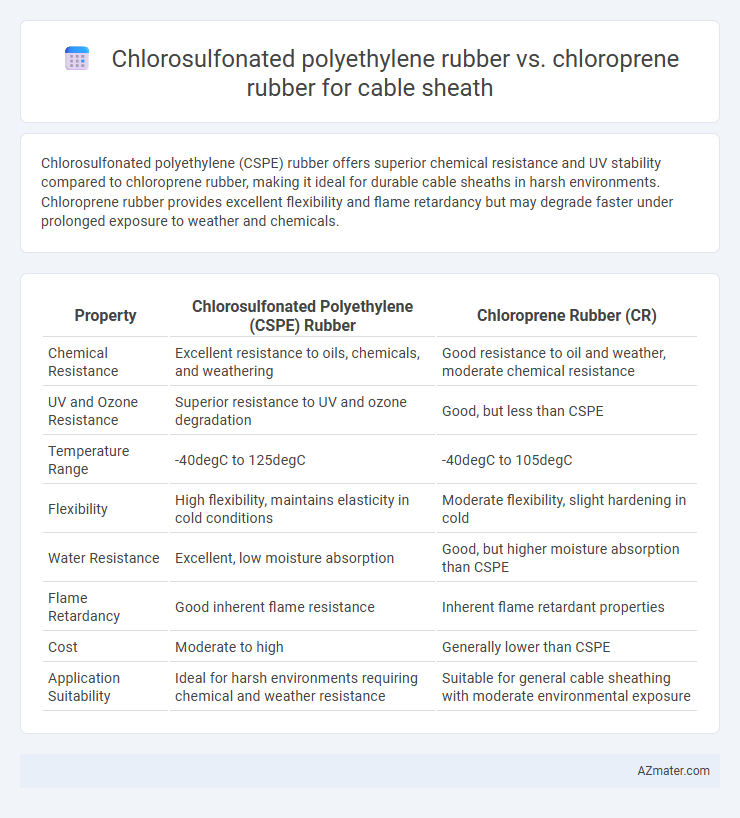Chlorosulfonated polyethylene (CSPE) rubber offers superior chemical resistance and UV stability compared to chloroprene rubber, making it ideal for durable cable sheaths in harsh environments. Chloroprene rubber provides excellent flexibility and flame retardancy but may degrade faster under prolonged exposure to weather and chemicals.
Table of Comparison
| Property | Chlorosulfonated Polyethylene (CSPE) Rubber | Chloroprene Rubber (CR) |
|---|---|---|
| Chemical Resistance | Excellent resistance to oils, chemicals, and weathering | Good resistance to oil and weather, moderate chemical resistance |
| UV and Ozone Resistance | Superior resistance to UV and ozone degradation | Good, but less than CSPE |
| Temperature Range | -40degC to 125degC | -40degC to 105degC |
| Flexibility | High flexibility, maintains elasticity in cold conditions | Moderate flexibility, slight hardening in cold |
| Water Resistance | Excellent, low moisture absorption | Good, but higher moisture absorption than CSPE |
| Flame Retardancy | Good inherent flame resistance | Inherent flame retardant properties |
| Cost | Moderate to high | Generally lower than CSPE |
| Application Suitability | Ideal for harsh environments requiring chemical and weather resistance | Suitable for general cable sheathing with moderate environmental exposure |
Introduction to Cable Sheath Materials
Chlorosulfonated polyethylene (CSPE) rubber offers exceptional resistance to weathering, ozone, and chemicals, making it ideal for cable sheath applications in harsh environments. Chloroprene rubber (CR) provides robust mechanical strength and excellent flame retardancy, which is critical for maintaining cable integrity and safety. Both materials contribute to enhanced durability and protection, yet CSPE is preferred for outdoor uses due to superior UV and abrasion resistance, while CR excels in environments demanding high thermal stability and flame resistance.
Overview of Chlorosulfonated Polyethylene Rubber (CSM)
Chlorosulfonated polyethylene rubber (CSM) is a synthetic elastomer known for exceptional weather, ozone, and chemical resistance, making it ideal for cable sheath applications in harsh environments. CSM exhibits superior tensile strength, flexibility, and flame retardancy compared to other rubbers, ensuring enhanced durability and safety. Its strong resistance to oils, solvents, and swelling enables prolonged sheath integrity, outperforming chloroprene rubber in aggressive industrial conditions.
Overview of Chloroprene Rubber (CR)
Chloroprene Rubber (CR) offers excellent resistance to weathering, ozone, and chemicals, making it highly suitable for cable sheaths exposed to harsh environments. Its superior flexibility and good mechanical properties ensure durability and long service life under mechanical stress and temperature variations. Compared to Chlorosulfonated polyethylene rubber (CSM), CR exhibits better toughness and is easier to process, enhancing manufacturing efficiency for cable insulation applications.
Key Physical Properties Comparison
Chlorosulfonated polyethylene (CSPE) rubber exhibits superior resistance to weathering, ozone, and chemical exposure compared to chloroprene rubber (CR), making it highly suitable for cable sheath applications requiring durability in harsh environments. CSPE offers excellent tensile strength, elongation, and abrasion resistance, while chloroprene provides good but slightly lower mechanical resilience and flexibility at low temperatures. Thermal stability of CSPE extends up to 130degC, outperforming chloroprene's typical range, contributing to prolonged cable sheath lifespan under elevated operating conditions.
Chemical Resistance of CSM vs CR
Chlorosulfonated polyethylene (CSM) rubber exhibits superior chemical resistance compared to chloroprene rubber (CR), particularly against oils, solvents, and acidic environments commonly encountered in cable sheath applications. CSM's molecular structure provides enhanced stability against oxidation, weathering, and chemical degradation, resulting in longer service life in harsh industrial settings. In contrast, CR offers good resistance to ozone and weather but is more susceptible to aggressive chemicals and hydrocarbon exposure, limiting its effectiveness in demanding chemical environments.
Weather and UV Resistance
Chlorosulfonated polyethylene rubber (CSPE) exhibits superior weather and UV resistance compared to chloroprene rubber, making it highly suitable for cable sheath applications exposed to harsh environmental conditions. CSPE's chlorosulfonated structure provides excellent resistance to ozone, UV radiation, and oxidative degradation, ensuring long-term durability and flexibility. Chloroprene rubber, while offering good general weather resistance, tends to degrade faster under prolonged UV exposure, limiting its effectiveness in outdoor cable sheath use.
Flame Retardancy and Fire Performance
Chlorosulfonated polyethylene rubber (CSM) offers superior flame retardancy and fire performance compared to chloroprene rubber (CR) in cable sheath applications, due to its high chlorine and sulfur content which enhance self-extinguishing properties and reduce smoke generation. CSM exhibits excellent thermal stability and resistance to fire propagation, making it suitable for environments with strict fire safety regulations. Chloroprene rubber, while flame resistant, generally produces more smoke and has lower overall fire retardant performance than CSM, impacting its suitability for high-risk fire hazard cables.
Processing Characteristics and Flexibility
Chlorosulfonated polyethylene rubber (CSM) offers superior processing characteristics for cable sheaths due to its excellent resistance to solvents, weather, and chemicals, enabling easier extrusion and vulcanization compared to chloroprene rubber (CR). CSM demonstrates greater flexibility at low temperatures, maintaining elasticity and durability in harsh environments, while CR provides moderate flexibility with good mechanical strength. The enhanced thermal stability and UV resistance of CSM make it a preferred choice for cable sheaths requiring long-term environmental resilience.
Cost Analysis and Market Availability
Chlorosulfonated polyethylene (CSPE) rubber generally offers lower raw material and processing costs compared to chloroprene rubber, making it a cost-effective choice for cable sheath applications. Market availability of CSPE is somewhat limited due to fewer global suppliers and less widespread use, whereas chloroprene rubber benefits from a well-established supply chain and broader market presence due to its long-standing applications in cable manufacturing. Cost analysis favors CSPE for budget-sensitive projects, but chloroprene remains more accessible and easier to procure in large quantities worldwide.
Application Suitability: Choosing the Right Rubber for Cable Sheath
Chlorosulfonated polyethylene (CSPE) rubber offers superior weather resistance, chemical resistance, and UV stability, making it ideal for outdoor cable sheaths exposed to harsh environments. Chloroprene rubber (CR) provides excellent flexibility and moderate chemical resistance, suited for applications requiring mechanical durability and abrasion resistance. For cable sheath applications demanding longevity under extreme weather and chemical exposures, CSPE is often preferred, whereas CR benefits installations prioritizing flexibility and toughness.

Infographic: Chlorosulfonated polyethylene rubber vs Chloroprene rubber for Cable sheath
 azmater.com
azmater.com